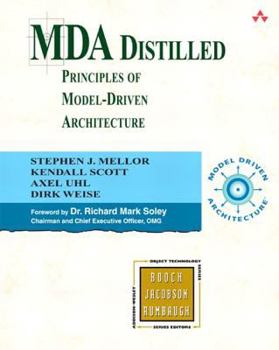MDA Distilled: Principles of Model-Driven Architecture
A readable and much needed introduction to MDA.--Dr. Jim Arlow, coauthor of UML and the Unified Process (Addison-Wesley, 2002) and Enterprise Patterns and MDA (Addison-Wesley, 2004)This book provides... This description may be from another edition of this product.
Format:Paperback
Language:English
ISBN:0201788918
ISBN13:9780201788914
Release Date:March 2004
Publisher:Addison-Wesley Professional
Length:150 Pages
Weight:0.85 lbs.
Dimensions:0.5" x 7.3" x 9.2"
Related Subjects
Computer Design Computer Science Computers Computers & Technology Design & Architecture Education & Reference Languages & Tools Methodology Microprocessors & System Design Object-Oriented Design Object-Oriented Software Design Programming Software Design & Engineering Software Design, Testing & Engineering Software Development Software EngineeringCustomer Reviews
2 ratings
An excellent introduction to MDA
Published by Thriftbooks.com User , 20 years ago
Model-driven architecture (MDA) is a potential next level of abstraction in the production of software. The principle is that the solution to the problem is expressed using a modeling language, which is then translated by a model compiler into source code. That source code is then converted into executable code. The potential for increased efficiency is obviously enormous. The ability to express solutions in a high- level abstract language alone will provide substantial benefits. Once it is possible to mechanically convert the solution into an executable form, one middle step in the software development process will be eliminated. While there are many legitimate doubts that can be expressed about the current state of MDA implementation, it has progressed to the point where all development teams should perform an initial investigation. When that point is reached, you should reach for this book. As the name implies, this is a primer/overview of what MDA is, how it is organized and the notations used to express the various elements of MDA. I found the book to be an excellent introduction to what MDA is, how it will be implemented and the advantages that it offers. It starts with a chapter on the basic terminology, which is followed by chapters on building models, building metamodels, building marking models, building languages and building executable models. I found the chapters on building marking models and building languages the most interesting. Marks are additional inputs used in the transformation of the model into source code. They are needed to represent the problem specific features of the current solution. Since there are so many different ways in which software is used, area specific modeling languages are needed. The description of how languages for this can be built was very interesting. At this point, no one knows how effective MDA will be in software development. However, there is no question that it will have an impact and this book will teach you the how and why.
Field still incomplete
Published by Thriftbooks.com User , 20 years ago
Over the decades, programmers have developed higher levels of abstraction in their languages. From the raw machine code of the 1940s to assembler to Fortran and later to C, C++, Java, C#. Once past assembler, all the higher constructs give us hardware independence. But suppose we have a system we want to code. The system could be defined textually or graphically. Currently, the implementation of a system is dependent on the software. MDA is an attempt to give us software independence. The promise is to build a model according to some rules. This model documentation can then be run through a black box that makes implementation code. The user does not have to know the details of the black box. Exactly analogous to how you might write a C program and then turn it over to a compiler. Clearly, there is immense value if MDA is possible. The authors say much of the value lies in the model being closer to what the user desires. Ideally, the user would draw up the model and be able to test it, without any knowledge of the lower, programming level. So there is no "verification gap". The document the user makes can be thus executed.Some of you will remember similar claims made for fifth generation languages and their like back in the late 80s. These would turn every user into a programmer, eh?! Unfortunately, those efforts failed. The problem was too hard. Sadly, as the authors themselves point out, MDA has not reached this goal either. A work still in progress. The book shows the current borders of research. It could do with some non-trivial examples. Important because of the abstract level of most of the discussion. Whilst there are some examples, they are of limited complexity.






